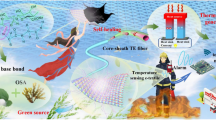Abstract
Optical fibers were embedded in a bonded composite patch in order to detect the strain field variations of a load bearing structure. The study concentrated on a classical cracked metallic structure repaired with this ‘smart’ patch and using finite element analysis. Six different laminates constituted the model of the composite patch, a layered structure with three-dimensional elements. Each laminate is assumed to have different mechanical properties, according to the case under any specific study, in order to simulate different stacking sequence or material used. A resin rich ‘eye’ pocket has also been modeled in order to simulate the exact form of the resin area produced during the manufacturing process. The patch is bonded over a cracked aluminum sheet through a small adhesive layer placed in between. External loads were applied only on the metal structure, as in a real repair case. The primary loading axis of the metal was assumed to be parallel to the direction of the optical fibers. The different nature of the materials that form the composite patch generated complex mechanical interactions between the fibers and the surrounding material, resulting in a complicated stress field along the optical fiber sensor, which affects the structural integrity of both the patch and the repair. Different optical fiber positions were considered, moving towards the horizontal and vertical dimensions of the patch, as well as different patch architectures (single and double patch configurations), with the hope of studying their effect on the structural integrity of the patch.
Similar content being viewed by others
References
Baker, A. A. and Jones, R., Bonded Repair of Aircraft Structures, Martinus Nijhoff Publishers, Dordrecht, 1988.
Marioli-Riga, Z. P., Tsamasphyros, G. J., and Kanderakis, G. N., ‘Development of a Method for A/C Emergency Repairs by Composite Patches’, in 1st Hellenic Conference on Composite Materials, Vol. II, S. A. Paipetis and E. E. Gdoutos (eds), Xanthi, Greece, 1997, pp. 14–156.
Baker, A. A., ‘Bonded Composite Repair of Metallic Aircraft Components - Overview of Australian Activities’, in Composite Repair of Military Aircraft Structires, AGARD CP-550, Seville, Spain, 1994, pp. –14.
Tsamasphyros, G. J., Kanderakis, G. N., and Marioli-Riga, Z. P., ‘Three-dimensional Finite Elements Analysis of Debonding and Thermal Effects Near the Crack-Tip of a Metal Structure Repaired by a Composite Patch’, in 3th Nat. Cong. on Comput. Mech., Vol. II, M. Aravas and J. T. Katsikadelis (eds), Univ. of Thessaly, Volos, Greece, 1999, pp. 42–436.
Marioli-Riga, Z. P., Tsamasphyros, G. J., and Kanderakis, G. N., ‘Non Destructive Evaluation of the Crack Propagation under a Composite Patch Repair Using the Eddy Current Method’, in SPIE’s 5th International Symposium on Nondestructive Evaluation and Health Monitoring of Ageing Infrastructure, Newport Beach, CA, USA, 2000.
Dasgupta, A. et al., ‘Prediction of Resin Pocket Geometry for Stress Analysis of Optical Fibers Embedded in Laminated Composites’, Smart Materials and Structures 1, 1992, 10–107.
ANSYS, Finite Elements Analysis Programme, Theory Manual.
Author information
Authors and Affiliations
Rights and permissions
About this article
Cite this article
Tsamasphyros, G., Furnarakis, N., Kanderakis, G. et al. Optimization of Embedded Optical Sensor Location in Composite Repairs. Applied Composite Materials 10, 129–140 (2003). https://doi.org/10.1023/A:1023916407469
Issue Date:
DOI: https://doi.org/10.1023/A:1023916407469




